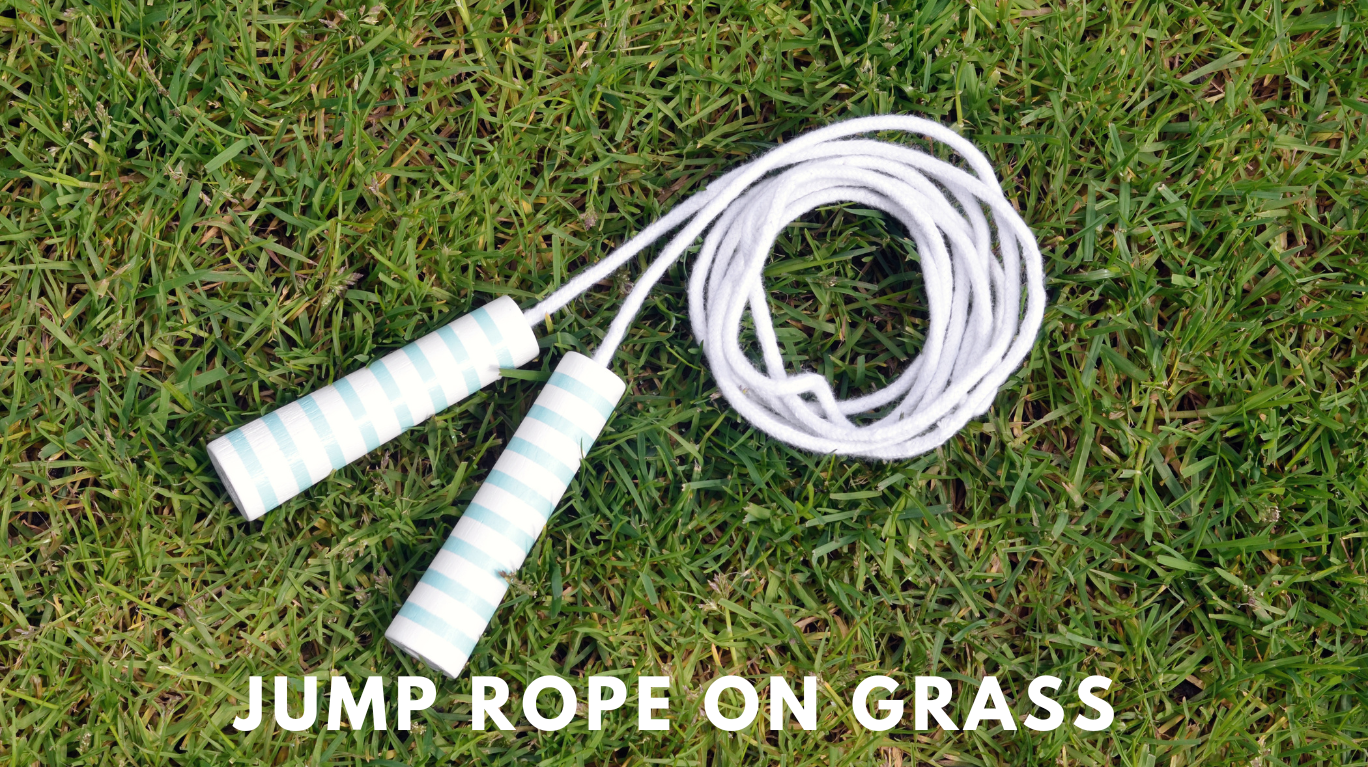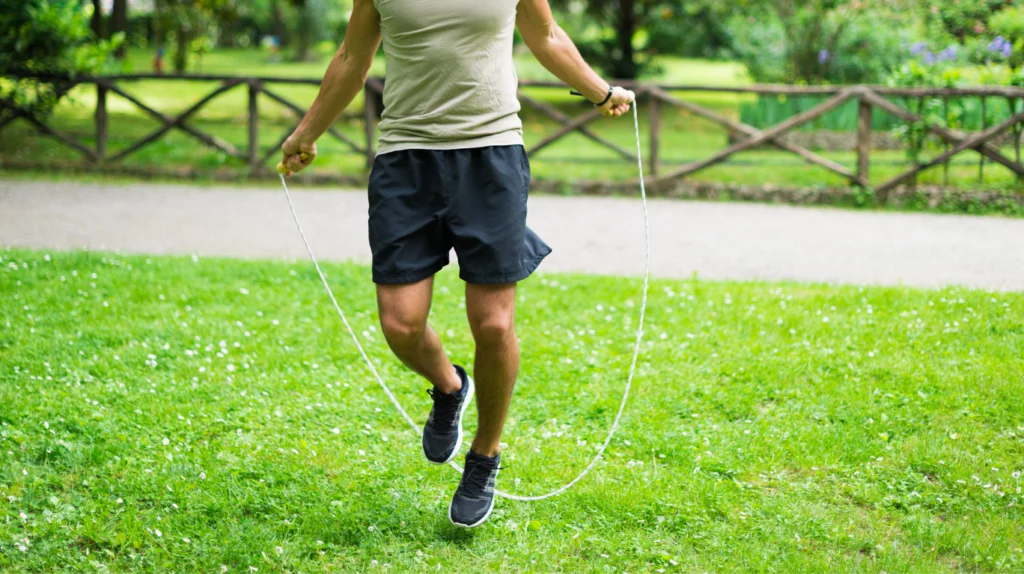Are you tired of the hard impact on your joints from working out on concrete or pavement? You’re not alone. Jumping rope on tough surfaces can be uncomfortable and a hurdle for many in their fitness journey.
Now, imagine a smoother and gentler option that cushions your jumps and saves your energy—jump rope on grass. This isn’t just another fitness trend; it’s a new way to exercise that combines the efficient calorie burn of jumping rope with the natural, forgiving feel of a grassy area.
And if you’re wondering, “Can you jump rope on grass?” The answer is yes! Get ready to explore a fitness world where safety and effectiveness come together, providing a workout that’s both gentle on your body and challenging.
Why Jump Roping is Beneficial
In a world where high-intensity workouts are popular, jumping rope is a top cardio exercise. It’s not just easy to do, but it also brings lots of health benefits. Jumping rope is a simple way to get your whole body in shape. Let us show you the amazing benefits of jumping rope.
1. Full-body Workout
Jumping rope is like conducting a symphony for your body. Each swing of the rope makes your arms, core, and legs work together, giving you a complete full-body workout. It’s not just a simple jump; it’s your whole body working in harmony.
2. Improved Cardiovascular Health
When you jump rope, your heart dances and gets stronger. It’s like a fun workout that makes your heart healthy and builds stamina. Jumping rope is like doing an energetic aerobic exercise.
3. Enhanced Coordination and Agility
This exercise is great because it makes your body and brain work together. It helps you become faster and better at balancing. So, you become a more agile and coordinated person.
4. Calorie Burning and Weight Management
Jumping rope burns a lot of calories and helps you lose weight. It’s like turning your exercise area into a fat-burning machine. Using a jump rope is a great way to manage your weight and get a leaner body by burning calories.
5. Mental Benefits
Jump roping isn’t just for the body; it’s good for the mind too. When you jump rope, you need to concentrate on timing and rhythm, making it like a meditation in motion. It helps you forget about the fast pace of everyday life and lets you focus on the rhythm of your jumps.
Jump Rope on Grass: Advantages and Disadvantages
Jumping rope on grass is fun and practical. It’s a cool way to change your exercise routine and make it more interesting. But, there are good and bad things about doing it on grass. Let’s look at the upsides and downsides to help you decide if it’s right for you.
Advantages of Jump Roping on Grass
Jumping rope on grass has some good points:
Shock Absorption: Jumping rope on grass is good for your joints because the grass is like a soft carpet from Mother Nature. It helps absorb shock, making it less likely for you to get hurt from jumping.
Muscle Engagement: Jump roping on grass is also good for your muscles. When you jump on the soft ground, your muscles have to work harder to stay balanced. This helps make your muscles stronger.
Nature and Fresh Air during Workouts: When you jump rope outside, you get fresh air. Breathing in nature not only helps your body but also makes you feel refreshed
Disadvantages of Jump Roping on Grass
Jumping rope on grass has a few drawbacks, such as:
Uneven and Unstable Surface: The grass is bumpy and not flat. It can have hidden bumps and holes that might trip you up while jumping, making it harder to keep a steady rhythm. This can lead to injuries like sprains.
Difficulty in Jumping: Because the ground is not even, it’s tough to swing the jump rope smoothly. This can cause more mistakes, and your jumping sessions might get interrupted.
Wear and Tear on the Jump Rope: The rope rubs against the grass a lot, which can wear it out quickly. Your jump rope might start to fray and get damaged sooner than if you jumped on a smoother surface.
Reduced Cardiovascular Benefits: Grass is soft, so jumping on it might not give you as good of a workout for your heart. To make up for it, you’d have to jump more intensely or for a longer time.
Choosing the Right Jump Rope for Grass
When you’re jumping rope on grass, it’s important to choose the right one. The first thing to consider is a rope that can handle the changing and sometimes wet grass. Choose a rope made to last and resist weather, like one with a coated cable or synthetic fiber that keeps out moisture and doesn’t wear out easily.
Secondly, grass can vary in length and texture, so you need a rope that can adjust easily. Get a rope with adjustable length so you can set it at the right height above the ground. This way, you’ll have an easy and efficient workout whether the grass is long or short.
Lastly, if you want to make your workout more challenging on grass, use a weighted rope. It adds extra weight, making your muscles work harder and burning more calories. This turns a regular jump rope session into an intense and special exercise.
Jump Rope on Grass: Essential Tips to Remember
Jumping rope on grass? Here are important tips to make it better. Follow these tips to improve your jumping skills and get better at it.
1. Surface Selection
Find a flat area with short, well-maintained grass. Avoid slippery or overly lush grass to prevent tripping and ensure a solid grip on your feet.
2. Warm-Up
Just like when you exercise, it’s important to do a good warm-up before jumping rope. Get your muscles ready for active jumping by doing stretches and jogging in place. This helps raise your heart rate and prepares your muscles for the fun workout ahead.
3. Consistent Speed and Rhythm
When you jump rope on grass, it’s important to keep a steady speed and rhythm. Don’t go too fast or too slow. This helps you build momentum and keeps your muscles working well for a better workout.
4. Body Positioning
Proper body positioning is crucial when jumping rope on grass. Stand with your hips and shoulders aligned parallel to the ground. This position ensures smooth jumps and prevents the rope from getting tangled.
5. Wrist Movement and Control
Hold the rope with your hands and keep your elbows near your body. Move your wrists to control the rope and avoid it touching the ground. It’s important to practice moving your wrists smoothly to keep the rope steady. This technique helps you keep a good pace during your workout and avoid any interruptions.
6. Consider Impact Forces
Grass isn’t just for looks; it provides a softer landing for your joints. When you jump on grass, it absorbs the shock naturally and protects your knees and ankles. Be careful to land softly and avoid hard landings to keep your joints safe from the impact of jumping rope.
Conclusion
In summary, jumping rope on grass can be both feasible and enjoyable. It’s clear that you can jump rope on grass, although this surface may not be the ideal choice for everyone. When you jump rope on grass, the softer surface can be gentler on your joints, which is a benefit to consider. However, the uneven terrain and potential for slipping mean that extra care is necessary. For those looking to add variety to their workout or seeking a joint-friendly option, jumping rope on grass might just be a good fit. Always ensure your safety and adapt your technique to the grassy terrain for an effective workout.
Common Queries
What is the ideal surface for jumping rope?
The best surface for jumping rope is smooth, level, and slightly yielding. This helps lower the chance of hurting yourself and makes it easier to keep rhythm.
Is a jump rope mat necessary?
A jump rope mat is good to have but not a must. It can absorb shock, and protect your rope from wear, and you can take it anywhere.
Which surface is better for jumping rope: concrete or grass?
Concrete is solid and stable for jumping rope but can be hard on your body. The grass is softer but can be uneven and cause mistakes or falls.
Can you jump rope without shoes?
Jumping rope without shoes is possible, but shoes give your feet support and protection against injury. It’s usually better to wear shoes.
Where should you aim to land when jumping rope?
When jumping rope, try to land softly on the ball of your foot. This helps maintain balance and reduce injury risk by not stressing your legs too much.
Why it is not recommended to jump rope on grass?
Jumping on grass is often not suggested because it is soft and uneven. This can make you lose your balance and trip, and it’s harder to swing the rope consistently.


